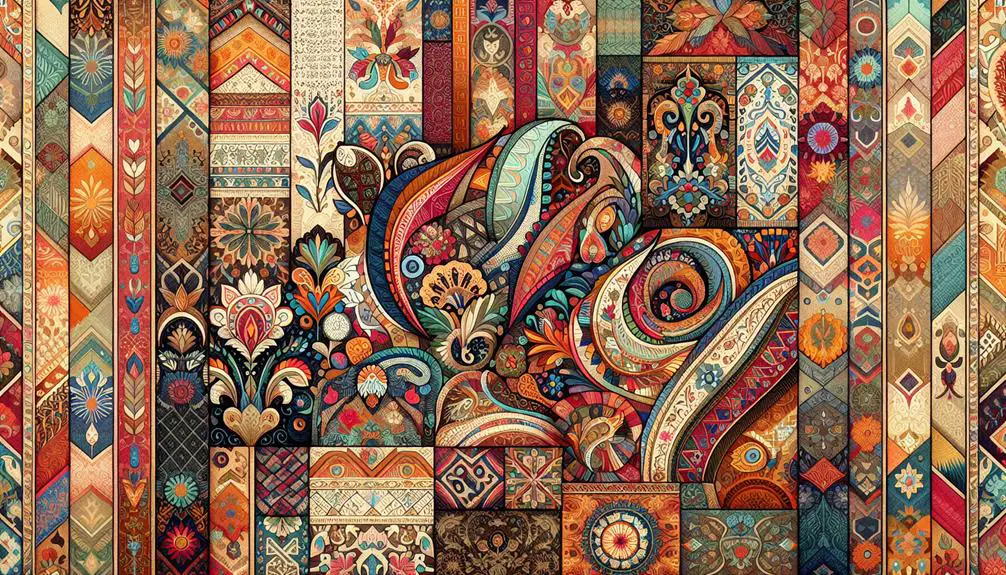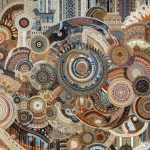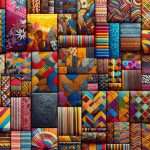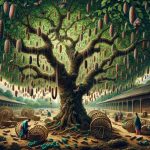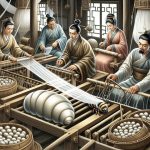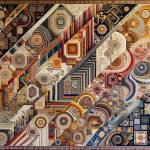Did you know that the earliest known silk fabrics, dating back to 3630 BCE in China, already featured complex brocades? Textile patterns aren't just about aesthetics; they're windows into the cultures that created them. Imagine the symbolic motifs in Egyptian linen or the intricate designs of Islamic geometric patterns. Each weave tells a story of societal values and technological innovation. How did these ancient techniques influence today's fashion industry and sustainable practices? You'll find that tracing the threads of history can unravel some fascinating connections.
Table of Contents
Key Takeaways
- Ancient Chinese silk brocades featured elaborate designs that conveyed status and told stories through motifs like dragons and floral patterns.
- Egyptian linen patterns showcased advanced weaving techniques and symbolic motifs such as the ankh, scarab beetle, and lotus flower.
- Islamic geometric designs used symmetrical, interlocking shapes to symbolize spiritual and philosophical meanings, reflecting harmony and infinity.
- Indian block printing involved artisans carving intricate designs into wooden blocks, using traditional motifs and sustainable, natural dyes.
- West African Kente cloth symbolized the rich cultural heritage of the Akan people, with each color and design carrying specific, meaningful narratives.
Ancient Chinese Brocades
When you think of ancient Chinese brocades, envision elaborate designs woven with vibrant silk threads that reflect centuries of artistry and culture. These brocades are a tribute to the mastery of silk weaving, a craft perfected over millennia.
As you explore further into their history, you'll discover that each pattern isn't just decorative; it tells a story, conveys status, and embodies the rich traditions of ancient China.
Silk weaving in China dates back to the Han Dynasty and even earlier. The meticulous process starts with the cultivation of silkworms, whose cocoons provide the raw material. Skilled artisans then dye the silk threads using natural pigments, achieving hues as varied as jade green and imperial yellow. The weaving itself is a complex dance of threads, often requiring sophisticated looms and techniques passed down through generations.
You'll find that these elaborate designs often feature motifs like dragons, phoenixes, and floral patterns—symbols of power, beauty, and prosperity. The attention to detail is remarkable, with some brocades incorporating gold and silver threads for added luxury.
Egyptian Linen Patterns
When you explore Egyptian linen patterns, you'll discover ancient weaving techniques that were both intricate and advanced.
These patterns often featured symbolic motifs with deep cultural meanings.
You'll also see how these ancient designs have influenced modern textile patterns today.
Ancient Weaving Techniques
Egyptian artisans mastered complex weaving techniques to create intricate linen patterns that have fascinated historians for centuries. You'll discover that their skills in crafting fine textiles were unmatched, often involving the use of advanced looms. They wove linen that wasn't just functional but also a canvas for elaborate designs, setting a standard for quality and craftsmanship that would influence other cultures.
In comparison, Greek embroidery techniques focused on embellishing fabrics with detailed stitching, while Mesopotamian textile art showcased symbolic imagery woven directly into their cloth. The Egyptians, however, specialized in producing extremely fine, almost translucent linen that served both everyday and ceremonial purposes. Their ability to create such delicate patterns without modern machinery is truly awe-inspiring.
Roman silk weaves and Persian rug designs also drew inspiration from early Egyptian methods, incorporating their meticulous attention to detail and sophisticated patterns. Roman artisans often sought to replicate the luxurious feel of Egyptian linen, while Persian weavers adopted the intricate designs into their own rich tapestry traditions.
Symbolic Motifs and Meanings
Many Egyptian linen patterns featured symbolic motifs that conveyed profound meanings, often tied to their religious and cultural beliefs. You'll find that these designs weren't just for decoration; they carried hidden symbolism and intricate details that reflected the society's values and traditions. For instance, the ankh symbol represented life, while the scarab beetle was a symbol of rebirth and protection. These patterns were more than just art—they were a language.
To better understand the cultural significance and traditional techniques behind these designs, examine the table below:
| Symbol | Meaning | Common Use |
|---|---|---|
| Ankh | Life | Tombs, Rituals |
| Scarab Beetle | Rebirth, Protection | Amulets, Clothing |
| Lotus Flower | Purity, Rebirth | Ceremonial Attire |
| Eye of Horus | Protection, Health | Jewelry, Linens |
Egyptian artisans mastered traditional techniques to embed these motifs into linen, ensuring each piece told a story. When you explore these patterns, you're not just seeing art; you're delving into a rich tapestry of history and meaning. Understanding this hidden symbolism can deepen your appreciation for these ancient textiles and the culture they represent.
Influence on Modern Designs
The timeless charm of these ancient Egyptian motifs continues to inspire contemporary textile designers, who often incorporate these powerful symbols into modern fabrics and home decorations.
You'll notice that contemporary interpretations of Egyptian linen patterns are rich with global influences, blending traditional symbolism with current trends.
With technological advancements, designers can now replicate elaborate Egyptian designs with remarkable precision. Digital printing techniques allow for the creation of complex patterns that were once meticulously hand-crafted. Additionally, sustainability trends have driven a resurgence in the use of natural fibers, making Egyptian linen—a fabric known for its durability and eco-friendliness—highly sought-after in today's market.
Consider how these elements come together to shape modern designs:
- Historical Resonance: The respect for ancient Egyptian culture imbues each piece with a sense of history and depth.
- Technological Precision: Advanced printing methods guarantee that even the most intricate motifs are faithfully reproduced.
- Sustainable Practices: The emphasis on eco-friendly materials aligns with the enduring, natural beauty of Egyptian linen.
Medieval European Tapestries
Imagine entering a grand medieval hall, where you'd be welcomed by the intricate and vibrant scenes portrayed on European tapestries. These masterpieces, crafted with medieval tapestry techniques, carry immense historical importance. Artisans utilized methods such as the high-warp and low-warp looms to weave stories into fabric. Tapestries weren't merely decorative; they insulated cold stone walls and portrayed significant narratives, from biblical scenes to chivalric tales.
European tapestry motifs developed artistically over time. Initially, they showcased religious themes, but as the medieval period advanced, tapestries started to incorporate more secular subjects, such as scenes of courtly life, mythological figures, and even daily activities. This artistic progression mirrors the changing preferences and cultural priorities of the era.
Here's a brief overview of key elements:
| Aspect | Description |
|---|---|
| Techniques | High-warp, low-warp looms; detailed weaving |
| Historical Significance | Insulation, storytelling, portrayal of biblical and chivalric themes |
| Artistic Evolution | Shift from religious motifs to secular subjects; intricate courtly scenes |
As you explore further into medieval European tapestries, you'll discover a rich tapestry of history and artistry that continues to enchant and motivate.
Islamic Geometric Designs
When you explore Islamic geometric designs, you'll notice their stunning mathematical symmetry.
These intricate patterns aren't just art; they hold deep cultural symbolism that reflects the unity and infinite nature of the universe.
Understanding these designs can give you a greater appreciation for the blend of science and spirituality in Islamic art.
Mathematical Symmetry in Art
Discover the captivating world of Islamic geometric designs, where mathematical symmetry transforms art into a tapestry of intricate patterns and cultural heritage. You'll find that these designs aren't just visually stunning but also a tribute to the creative fusion of geometry and art.
By mastering the use of shapes like circles, squares, and stars, Islamic artists have created patterns that repeat endlessly, symbolizing the boundless nature of the universe.
Islamic geometric art emphasizes precision and balance, achieved through the meticulous application of mathematical principles. This isn't simply about drawing shapes; it's about understanding the connections between them and using that knowledge to create harmonious designs.
As you explore further, you'll notice how each pattern invites you to navigate its intricate complexity, reflecting an underlying order and unity.
- Interlocking Shapes: Observe how various shapes interconnect seamlessly, showcasing a deep understanding of geometric principles.
- Symmetrical Patterns: Admire the equilibrium and harmony in patterns that reflect each other, fostering a sense of unity and coherence.
- Endless Repetition: Acknowledge the utilization of recurring motifs to signify infinity, a fundamental concept in Islamic philosophy.
Embrace these perspectives and enhance your admiration for the artistry and mathematical brilliance behind Islamic geometric designs.
Cultural Symbolism in Patterns
Embedded within Islamic geometric designs, the cultural symbolism reveals itself through patterns that convey spiritual and philosophical meanings. As you explore these intricate designs, you'll notice how traditional motifs like stars and polygons reflect the infinite nature of the universe and the unity of creation. These elements aren't just decorative; they embody profound cultural significance, drawing from centuries of Islamic art and thought.
Consider the role of color psychology in these patterns. Islamic art often uses specific colors deliberately to evoke particular emotions and spiritual states. For instance, blue symbolizes tranquility and divine protection, while green represents paradise and eternal life. By understanding these color choices, you can gain deeper insight into the cultural symbolism embedded in each pattern.
Moreover, contemporary adaptations of these designs allow you to see how ancient motifs continue to inspire modern art forms. Today, artists and designers integrate traditional Islamic geometric patterns into various media, from textiles to digital art, creating a fusion that bridges past and present. By mastering these patterns and their meanings, you'll appreciate the rich tapestry of cultural and spiritual significance that they carry, offering a timeless connection to Islamic heritage.
Indian Block Printing
Indian block printing, a centuries-old art form, captivates with its intricate designs and vibrant colors. You'll be amazed by how artisans use wooden blocks carved with precision to create stunning patterns on fabric. The block printing techniques involve dipping these blocks in dye and pressing them onto cloth, a method that demands skill and patience.
Each block is meticulously carved with traditional motifs, ranging from floral patterns to geometric shapes, reflecting India's rich cultural heritage.
Mastering this art form involves understanding the subtleties of design and dye application. Artisans often follow age-old processes passed down through generations. You'll find that the synergy between the artisan's hand and the wooden block results in a unique, handcrafted aesthetic that machine printing can't replicate.
- Authenticity: Each piece is a tribute to the artisan's dedication and skill.
- Cultural Significance: Traditional motifs tell stories of India's diverse cultural fabric.
- Sustainability: Using natural dyes and hand techniques reduces environmental impact.
West African Kente Cloth
West African Kente cloth dazzles with its vibrant colors and intricate patterns, symbolizing the rich cultural heritage of the Akan people. You're drawn to its beauty, but it's the Kente craftsmanship that truly captivates. Each piece is a tribute to the traditional weaving techniques passed down through generations.
Kente weaving isn't just about making cloth; it's an art form. The weavers, often master craftsmen, use looms to interlace threads in complex patterns. Every color and design has a meaning, often reflecting proverbs, historical events, or social status. As you explore deeper, you'll see that Kente is more than fabric—it's a narrative woven into every thread.
Here's a brief look at some of the symbolic meanings:
| Color | Symbolism |
|---|---|
| Black | Maturity, Spirituality |
| Red | Political and Spiritual Aspects |
| Green | Growth, Fertility, Renewal |
| Yellow | Wealth, Royalty, Prosperity |
Understanding these meanings adds layers to your appreciation of Kente. Mastering Kente cloth knowledge involves recognizing its cultural significance and the meticulous craftsmanship behind it. You'll find that every piece of Kente tells a unique story, reflecting the vibrant spirit and history of the Akan people.
Modern Textile Innovations
As you explore modern textile innovations, you'll discover groundbreaking technologies that are revolutionizing the fabric industry. Sustainable fabrics, for instance, are at the forefront of this transformation. These materials, made from eco-friendly resources like organic cotton, bamboo, and recycled polyester, are redefining what it means to be fashion-forward. By choosing these fabrics, you not only support the environment but also promote a healthier, more sustainable future.
Digital printing techniques have also revolutionized textile design. Unlike traditional methods, digital printing allows for intricate and vibrant patterns to be embedded directly into the fabric with precision and speed. This technology reduces waste and provides designers with unparalleled creative freedom.
To explore further into these innovations, consider the following:
- Sustainable Fabrics: Understand the environmental impact and benefits of using eco-friendly materials.
- Digital Printing Techniques: Investigate how digital printing can create complex designs with less waste.
- Technological Integration: Learn about smart textiles that incorporate technology for enhanced functionality.
Frequently Asked Questions
How Have Textile Patterns Influenced Modern Fashion Design?
You can see how cultural influences in textile patterns shape modern fashion design. They've driven fashion evolution by blending traditional styles with contemporary trends, creating unique looks that resonate across different cultures and time periods.
What Role Do Textile Patterns Play in Cultural Identity Today?
Imagine wearing a traditional Japanese kimono; you're not just donning fabric, but expressing deep cultural significance. Textile patterns play an important role in identity expression, reflecting heritage and fostering a shared sense of belonging.
How Are Historical Textile Patterns Preserved in Museums?
You'll find that museums preserve historical textile patterns through advanced conservation methods and preservation techniques. They showcase these patterns in museum displays and integrate them into educational programs, ensuring their cultural significance is maintained and understood.
What Are the Environmental Impacts of Traditional Textile Production Methods?
You might think traditional methods are charming, but they can harm the environment. They often lack sustainable practices, increasing the carbon footprint and textile pollution. Embrace eco-friendly alternatives to minimize these impacts and promote a greener future.
How Do Contemporary Artists Incorporate Traditional Textile Patterns in Their Work?
You'll see contemporary artists blending traditional motifs with innovative techniques, creating artistic interpretations that honor the past. This cultural fusion breathes new life into age-old patterns, offering a fresh perspective while maintaining historical integrity.
- Recycling Nonwoven Fabrics: Is It Possible? - July 11, 2025
- Recycling Nonwoven Fabrics: Is It Possible? - July 11, 2025
- Recycling Nonwoven Fabrics: Is It Possible? - July 11, 2025

